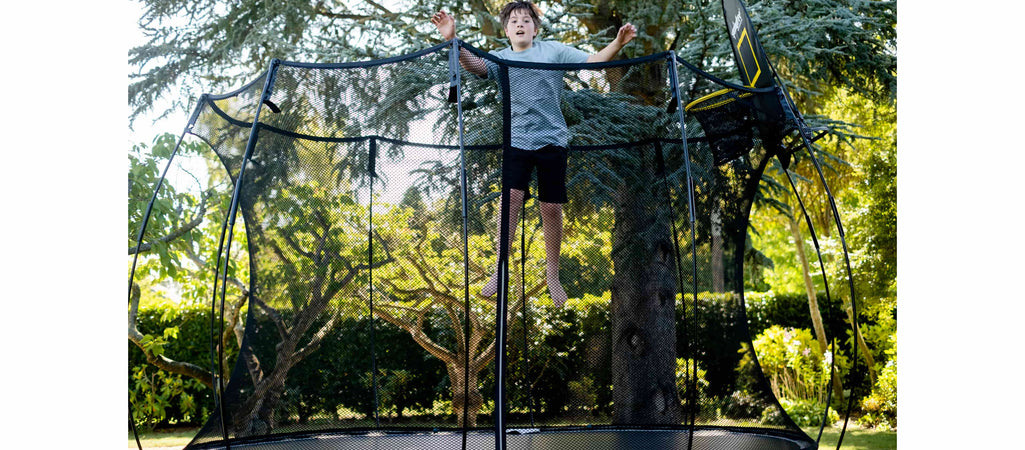Can You Put a Normal Trampoline In the Ground? | Expert Insight
Can you put a normal trampoline in the ground? Are they safe? Springfree Trampoline provides expert advice for a safer jumping experience.
min read

Trampolines are a popular way for kids and adults to get exercise and have fun.
However, they can also be dangerous, especially if they are not properly installed. One question that many people have is whether it is safe to put a normal trampoline in the ground.
At Springfree Trampoline, we have firsthand experience helping customers answer this question. We will use this article to share our insight, so you keep your kids jumping safely.
So…Can You Put a Normal Trampoline In the Ground?
Let’s get right to it: Can you put a standard backyard trampoline in the ground?
Technically, yes. You can put a normal trampoline in the ground. Should you, though? Absolutely not.
Let’s back up a bit and talk about what a "normal trampoline" is.
What Is a Normal Trampoline?
When somebody says “normal trampoline” they are talking about an above-ground trampoline. These are your typical backyard trampolines:

This is an important distinction because there are trampolines that are installed in the ground, called inground trampolines. Here’s what an inground trampoline looks like (courtesy of Rectangle Trampoline):

The topic of discussion today will center on installing above-ground trampolines into the ground.
If you would like to learn more about inground trampolines, we’ve previously written articles about the cost of inground trampolines and inground trampolines vs. above-ground trampolines.
6 Consequences of Putting a Normal Trampoline In the Ground
There are serious consequences to putting a normal trampoline in the ground – let’s go over each of them in more detail.
1. More Work/Money
The first downside to placing a normal trampoline in the ground is it takes A LOT of digging.
Adding the digging to the work it already takes to fully assemble the trampoline is not ideal. Many people don’t understand how much work it will take to bury the legs of the trampoline once it is assembled.
You would be hard-pressed to dig a hole large enough to put a trampoline in the ground over a weekend. You also may need to install a retaining wall for support. Here’s what this process could look like, via Creative Design Landscaping LLC:

If you don’t want to do the digging and assembling yourself, you would have to hire professionals to do this.
2. Less Safe
The most severe consequence of putting a normal trampoline in the ground is it can increase the risk of suffering a trampoline injury. This is because:
- Installing a normal trampoline in the ground can further expose anymetal parts, like the trampoline springs.
- The soil in the hole may erode the trampoline parts over time, potentially causing jumpers to hit the ground due to frame deterioration.
- Gaps can occur around the edge of the frame, again exposing the springs and risking pinching injuries to toes and feet.
Your response to the points above might be, “Well what if I buy a springless trampoline instead? That eliminates two of the consequences.”
It’s just not worth the risk. You may significantly increase your chances of bottoming out due to soil erosion with a springless trampoline. Not to mention the risk of injury if the trampoline becomes unstable due to improper installation.
3. Bounce Quality Reduced
Another negative effect of placing a normal trampoline in the ground is it can reduce the trampoline’s bounce quality.
This is primarily due to the science behind the trampoline bounce. When you jump on a trampoline, the air underneath the trampoline moves away and escapes around the sides.
If you put a normal trampoline in the ground, that air has nowhere to go but upwards, which can greatly diminish the bounce quality. The air pressure may also deteriorate and weaken your trampoline springs.
4. Loses Visual Appeal for Some
Normal trampolines are not built to go in the ground. You can imagine, then that a normal trampoline with its legs in the ground would probably look…awkward.
Everybody has different opinions on what is visually appealing. It would take some creativity, though, to make a trampoline with its legs buried look better than it would above the ground.
5. Difficult to Relocate
Once you put a trampoline in the ground, it becomes a more permanent fixture in your backyard.
This means if you wanted to move the trampoline or get rid of it, you would have to dig it out of the ground. Just like placing the trampoline in the ground, work, time and potentially money are required to safely disassemble it.
6. Shorter Lifespan
Lastly, putting a normal trampoline in the ground can shorten the lifespan of a trampoline.
A trampoline buried underground will be in contact with damp soil and air, which may cause the trampoline frame and springs to rust. Rust of any kind on a trampoline weakens its structure, causing both safety and longevity concerns.
The maintenance for an above-ground trampoline that is buried in the ground would also likely be increased. This includes potentially changing the trampoline springs out every year.
Why Do People Put Trampolines in the Ground?
With all these consequences considered, why would somebody choose to put a normal trampoline in the ground?
It could be for various reasons, including extra stability from windy weather conditions. Again, the risk/reward and effort/impact are just not worth it.
If you live in a windy area, you can buy trampoline anchors to help anchor down your above-ground trampoline. There’s really no rational reason to place a normal trampoline in the ground.
If you want a trampoline in the ground, buy an inground trampoline kit. They are meant to be installed in the ground and you would reap some of the benefits of having a trampoline that sits ground level. The benefits of inground trampolines include:
- Reduced risk of falling injuries.
- Might be more aesthetically pleasing than an above-ground trampoline (although this depends on the trampoline brand).
- More durable than your typical above-ground trampoline.
- Easier entry/exit points.
However, the cost of installing an inground trampoline can run up to $5,000 or more, which is not practical for some.
The inground trampoline installation process can also be long and tedious. You likely will have to hire professional trampoline installers to install an inground trampoline correctly. Make sure to consider these factors before deciding on an inground trampoline.
Normal Trampolines Don’t Belong in the Ground
While you can technically sink a normal trampoline into the ground, it’s not worth the time, effort or safety risks.
If you want a trampoline that lies beneath the ground, buy an inground trampoline kit and have professionals come install it for you. That’s the safest and most effective way to get a trampoline in the ground.
Need Trampoline Accessories to Upgrade Your Trampoline?
If you’re thinking about placing a normal trampoline in the ground, you may be concerned about the safety or durability of your trampoline.
Trampoline accessories are available to help make your trampoline safer, more durable and accessible – all while keeping the trampoline above the ground. Here are some examples:
- A trampoline ladder for easier access.
- Trampoline anchors to keep your trampoline from blowing away.
- Trampoline wheels to help move the trampoline by yourself.
- A trampoline basketball hoop for the kids to dunk on.
If you have a Springfree Trampoline, have a look at our trampoline accessories and see if one might be a fit to enhance your bouncing experience!

